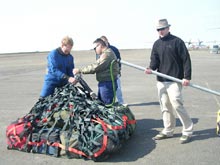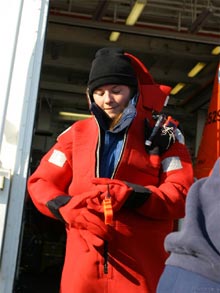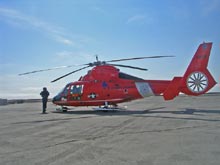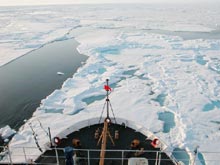
Members of the Healy crew and aviation division work together to secure luggage and equipment in a net to be flown to the USCGC Healy by helicopter. Click image for larger view.
Mobilizing The USCGC Healy And Flight Operations
June 26-27, 2005
Kelley Elliott
Web Coordinator
NOAA Office of Ocean Exploration
![]() US Coast Guard Helicopter flies four members of the science team to the USCGC Healy. (mp4, 2.03 MB.)
US Coast Guard Helicopter flies four members of the science team to the USCGC Healy. (mp4, 2.03 MB.)
“Hurry up and wait,” has shown itself the prominent theme of the past two days. Scientists, ROV operators, and expedition supporters ferried their way to our gathering point for the day, the North Slope Borough Department of Search and Rescue hangar, meeting at 7am. Introductory greetings are exchanged as we await the start of operations.
Our work schedule includes preparing luggage and equipment, then flying the equipment and scientists to the Coast Guard Cutter Healy which sits about 5 miles offshore. Alas, mother nature does not cooperate with our plans. Heavy fog clouds morning visibility, preventing the US Coast Guard helicopters from flying until mid-afternoon. North Slope Barrow's Department of Search and Rescue (SAR) helicopter, a larger helicopter arranged to fly our heaviest equipment, flew out to a nearby town early in the morning to recover the bodies of two campers killed by a grizzly bear.
Flight operations required to mobilize the USCGC Healy for this expedition provide a unique situation compared to other scientific cruises. Healy sits 5 miles offshore and is unable to come to port in North Slope Barrow because near-shore waters are too shallow. Extensive coordination with Healy's impressive aviation division takes place to get crew, scientists and equipment on board safely and smoothly. This particular expedition, however, requires further flight assistance to get really heavy equipment, including a 2700 pound Remotely Operated Vehicle (ROV) on board. A request for help from SAR to get equipment over to the Healy needed approval by the mayor, and was kindly received.
By mid-afternoon the fog lifted and two US Coast Guard helicopters flew to the Search and Rescue hangar to begin operations. Equipment sent to the Barrow Arctic Science Consortium (BASC) weeks before has been brought to the SAR hangar, and additional help retrieving luggage lost by the airlines is received from BASC logistics coordinators, Alice and Henry. Scientists and crew weigh and tag each piece of luggage and equipment before systematically moving everything onto nets where Coast Guard personnel secure them for the helicopter flight.
The first helicopters blades begin rotating at an accelerating pace as nearly the entire science party stands a safe distance away with cameras in hand. One helicopter lifts about 20 feet off the ground and slowly flies over top of the first net filled with bags and equipment, stopping with its mid-section overtop of the cargo net. A flight operations ground support person cautiously approaches the cargo net and reaches up and attaches a pole from the net to a hook on the underside of the helicopter, pulling to check the connection before giving the helicopter pilot a thumbs up to lift off, stepping away. The helicopter slowly lifts up with the cargo securely attached before flying out to the USCGC Healy 5 miles offshore.
Once the lighter cargo and equipment is flown out, the helicopter returns to take members of the science party and ships crew on board. The first persons to fly out are called, two to four at a time due to space limitations in the helicopter. They change into bright orange “Mustang suits” intended to keep them warm and visible in case of an emergency, and are given a safety briefing on helicopter operations, including how to quickly release the helicopter's harness-style seatbelt and what controls NOT to touch.
Once the helicopter readies for takeoff, the first scientists are led to the helicopter, cautiously bending forward when going underneath the dangerous spinning blades, and are helped into the helicopter by aviation ground support. Before takeoff the pilot confirms the name of each person on board and transmits the information to USCGC Healy before takeoff. As the helicopter continues to lift higher and fly in a sideways arc, Northslope Barrow, Alaska comes into aerial view providing a glimpse of America's northernmost point set against icy Arctic waters.
The Research Vessel Healy first appears as a speck in open Arctic waters before slowly displaying its white and red Coast Guard stripe. The empty deck full of equipment comes into view as you near the ship, and finally the white circle marking the helicopter landing pad becomes clear as the pilot gently sets the helicopter down. The roar of the spinning blade almost shocks you when the helicopter doors open and you exit the helicopter, directed by Coast Guard members to safety inside the ship. The whole trip has lasted less than 10 minutes.

Kelley Elliott, web coordinator for the Hidden Ocean expedition, practices emergency safety procedures by trying on a “gumby suit” for the first time. Click image for larger view.
Once on board the vessel you are given your room assignment and a short period to settle in and get to know the layout of the boat. The scientists on board busily set up their equipment for the cruise ahead while crewmen check to ensure the vessel is operating safely. Once all the crew and scientists are on board, meetings are called to go over rules, planning logistics and safety on the boat. Following a safety briefing prepared by the crew, all members of the science party are taken out on deck to go over emergency evacuation procedures. Such procedures include evacuation routes, emergency lifeboat assignments, and “gumby suits.”
After the safety briefing everyone departed to finish setting up their materials and secure gear before the ship set underway. Helping with ship operations, coordinating materials, communicating to shore, connecting computers to the ships network, and aiding in nearly any problem that arises are the wonderful Healy Crew and Marine Science Technician's, whose help and knowledge are integral to getting and keeping science operations going. About an hour later slight vibrations in the ship are felt as we set out towards the Arctic ice.
Sign up for the Ocean Explorer E-mail Update List.


































